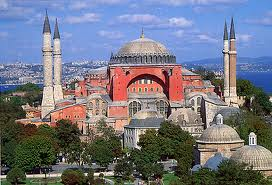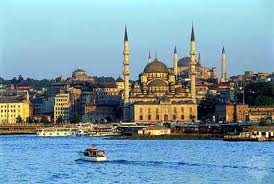|
The Golden Age Byzantine architecture was under the rule of Justian in 527-565. It was during this time that the most famous examples of Byzantine architecture was built for everyone, including the Hagia Sophia. The Hagia Sophia was built in 532-537, after the previous church was destroyed by riots and fires. This church has some unique features that has been the pattern for years to Byzantine architecture.
Much of Byzantine architecture was created to express religious experience and mediate between the believer and God. Taken in its architectural context, the iconographic program of the mosaics and frescoes of the Kariye Camii envelopes the believer within scenes of the Old Testament and the lives of Christ and Mary Mother of God. Visual expressions of faith within the context of the Eucharist and other religious ceremonies then provide layers of meaning, even the primary context, to the architectural heritage of the Byzantine world.

The architects of St. Sophia were Asiatics: Anthemius of Tralles and Isodorus of Miletus. In other great basilicas, as here, local influences had great power in determining the character of the architecture, e.g. the churches of the Nativity, of the Holy Sepulchre, and of theAscension, built in Palestine after the time of Constantine. This is still more evident in the costly decorations of these churches.
The Oriental love of splendour is shown in the piling up of domes and still more in facing the walls with slabs of marble, in mosaics (either opus sectile, small pieces, or opus Alexandrinum, large slabs cut in suitable shapes), in gold and colour decorations, and in the many-coloured marbles of the columns and other architectural details.

The style of the Hagia Sophia or Church of Divine wisdom, was to have a large dome in the middle of the structure. The dome has a unique form in that it rest on 4 massive pillars which are arranged in a square.
The dome remained the main focus of the Byzantine Church for the remainder of the empire.Basil I (867-886), like many of his predecessors, built in the area of the Great Palace, two churches: the New Church and the Church of the Theotokos of the Pharos. These set a fashion in church building and decoration that was to exercise an influence for many centuries.
Neither survives, but something is known of them from written descriptions, and it would seem that both were typical of what was to be the mid-Byzantine style. Broadly speaking, the churches of this age conform to a single type, usually termed the cross-in-square. It is made up of three aisles, each one terminating in an apsidal chapel at the east, with a transverse nave, known as the exonarthex, at the west.
|

![]()

